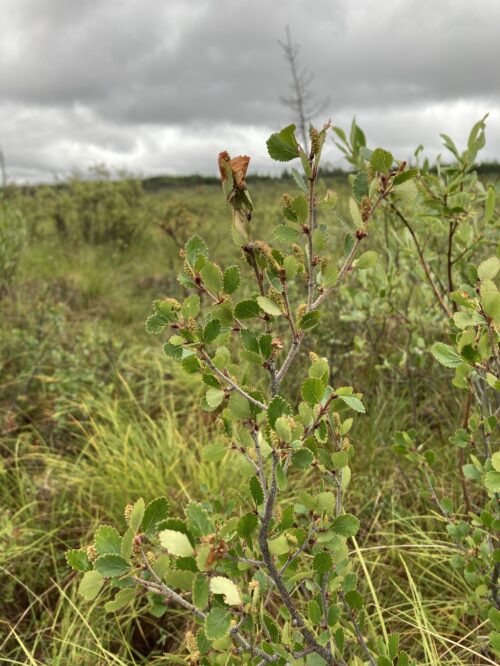February 19, 2024
Above- and Belowground Tundra Shrub Traits Respond Differently to Microenvironmental and Macroclimatic Variation
Microsite conditions affect how shrub traits respond to climate in Arctic tundra.

Betula shrub in the Arctic tundra.
[Courtesy Jennifer Fraterrigo, University of Illinois Urbana-Champaign.]
The Science
Plant traits are attributes that can influence plant performance in different environments and may thereby determine the ability of individual plants to respond to climate change. Understanding the patterns and factors that lead to trait variation across different spatial scales is important for predicting how biodiversity and ecosystem functioning will change in the future, especially in understudied regions like the Arctic. A team of researchers examined above- and belowground traits from three shrub groups expanding across the Alaskan tundra and evaluated their relationships with local environmental and climatic factors. The research found substantial variation in traits at small spatial scales (within sites) and less variation between sites with different climates and between shrub taxa. Local environmental factors, mainly soil moisture and thaw depth, interacted with climatic water deficit to predict variation in shrub height and leaf traits. In contrast, most root traits responded additively to thaw depth and macroclimate.
The Impact
Results demonstrate that above- and belowground tundra shrub traits respond differently to local environmental and climatic variation. These differing responses contribute to substantial trait variation at small spatial scales and suggest that above- and belowground traits will respond differently to climate change. This may preclude inferring belowground trait responses from more easily detectable aboveground responses. Additionally, results suggest models should account for trait variation and its drivers to increase the accuracy of climate change predictions.
Summary
A team of scientists examined how patterns of trait variation differ across sites, within and among taxa, and across plots. They also investigated the primary environmental drivers of trait variation across these different spatial scales. Findings suggest that above- and belowground tundra shrub traits respond differently to local environmental and climatic variation. Soil moisture, thaw depth, and climatic water deficit were important predictors of variation in shrub size and leaf traits in the Alaskan tundra. In contrast, root traits were more sensitive to thaw depth.
Principal Investigator
Jennifer Fraterrigo
University of Illinois Urbana-Champaign
jmf@illinois.edu
Program Manager
Daniel Stover
U.S. Department of Energy, Biological and Environmental Research (SC-33)
Environmental System Science
daniel.stover@science.doe.gov
Funding
Funding from DE-SC0016219 and DE-SC0021094 was instrumental in data collection and personnel support.
References
Fraterrigo, J. M., et al. "Soil Microenvironmental Variation Drives Below-Ground Trait Variation and Interacts with Macroclimate to Structure Above-Ground Trait Variation of Arctic Shrubs." Journal of Ecology 112 (4), 901–16 (2024). https://doi.org/10.1111/1365-2745.14278.

